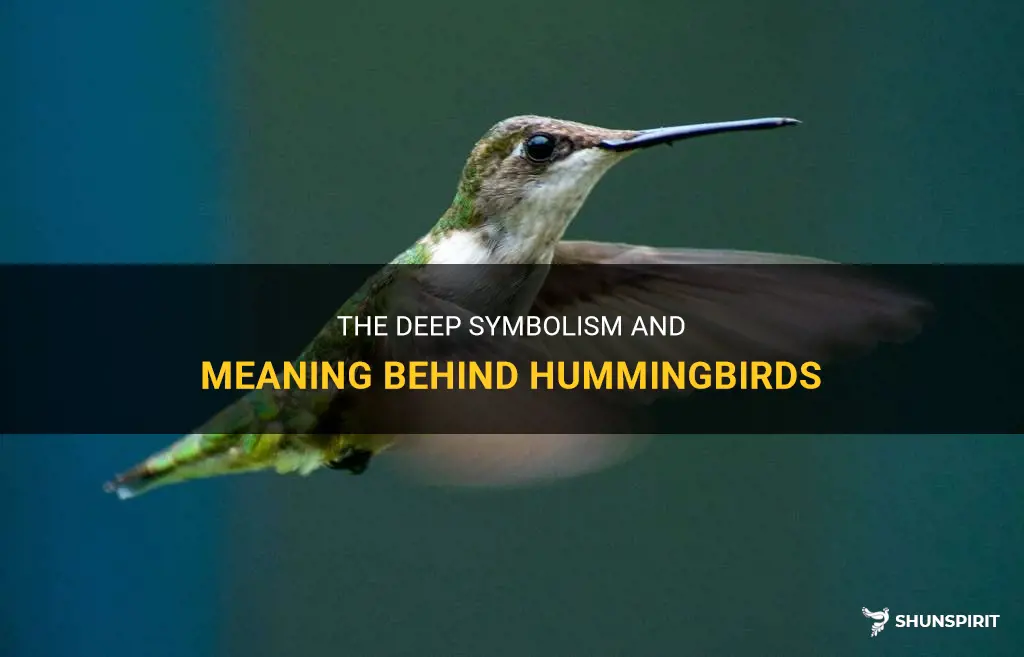
Hummingbirds, known for their vibrant colors and seemingly magical ability to hover in mid-air, have captivated humans for centuries. Beyond their physical beauty, these enchanting birds also hold a deep symbolic meaning in various cultures around the world. Their presence is often associated with joy, resilience, and the fleeting nature of life. By exploring the fascinating world of hummingbird symbolism and significance, we can gain a deeper understanding of the interconnectedness between nature and our own human experiences.
What You'll Learn
- What is the significance of the hummingbird in various cultures and traditions?
- How has the symbolism of the hummingbird evolved throughout history?
- What do different colored hummingbirds represent in terms of symbolism and meaning?
- Are there any specific spiritual or metaphysical beliefs associated with hummingbirds?
- How can the symbolism of the hummingbird be interpreted in terms of personal growth and transformation?

What is the significance of the hummingbird in various cultures and traditions?
Hummingbirds are small, colorful birds that are found mainly in the Americas. They are known for their ability to hover in mid-air and their rapid wing beats, which produce a humming sound. These birds have captivated human imagination for centuries and are seen as symbols of various cultural and spiritual beliefs. In this article, we will explore the significance of the hummingbird in various cultures and traditions.
In Native American cultures, the hummingbird is often seen as a messenger of joy, love, and beauty. It is believed to bring good luck and positive energy to those who see it. In some tribes, such as the Hopi and Pima, the hummingbird is associated with fertility and is seen as a symbol of abundance and happiness. In other tribes, such as the Zuni and Apache, the hummingbird is considered a messenger between the mortal world and the spirit world.
In Aztec culture, the hummingbird was associated with the sun and was often depicted in art and architecture. The Aztecs believed that hummingbirds were the reincarnation of fallen warriors and that they would accompany them on their journey to the afterlife. The hummingbird was also seen as a symbol of warriors who had died in battle, as their swift movements and agility were seen as a reflection of the bravery and strength of these warriors.
In Mayan culture, the hummingbird represented resurrection and rebirth. The Mayans believed that the souls of deceased warriors would transform into hummingbirds and continue to provide protection and guidance to their living descendants. The hummingbird was also seen as a symbol of love and courtship, and it was believed that seeing a hummingbird would bring good luck to romantic relationships.
In Hawaiian culture, the hummingbird is known as "ʻIʻiwi," and it is associated with the goddess Pele, who is the goddess of fire, lightning, and volcanoes. The ʻIʻiwi bird is considered a symbol of passion, power, and transformation. It is believed that seeing an ʻIʻiwi bird is a sign that Pele is present and that there is a spiritual transformation occurring in one's life.
In Chinese culture, the hummingbird is associated with good fortune, happiness, and longevity. It is believed that the presence of a hummingbird brings joy and good luck to a household. The hummingbird is also seen as a symbol of perseverance, as it tirelessly searches for nectar and sustenance. In Chinese art, the hummingbird is often depicted alongside flowers, symbolizing the pursuit of beauty and harmony.
In summary, the hummingbird holds great significance in various cultures and traditions. It is seen as a messenger of joy, love, and beauty in Native American cultures, a symbol of warriors and sun in Aztec culture, a representation of resurrection and rebirth in Mayan culture, a symbol of passion and transformation in Hawaiian culture, and a sign of good fortune and happiness in Chinese culture. These diverse interpretations of the hummingbird reflect the profound impact these tiny creatures have had on human imagination and spirituality throughout history.
Decoding the Meaning Behind eharmony's Shield Symbol
You may want to see also

How has the symbolism of the hummingbird evolved throughout history?
The symbolism of the hummingbird has evolved throughout history, reflecting different cultural beliefs and interpretations. This small and vibrant bird has captivated the imaginations of people around the world, leaving a lasting impression on various aspects of human society and spirituality.
In ancient Native American cultures, the hummingbird was seen as a symbol of joy, love, and beauty. These cultures often depicted the bird in their art and legends, showing its connection to the natural world and the harmony of life. The hummingbird was believed to bring good fortune and happiness, and its presence was seen as a sign of blessings and abundance.
In Aztec mythology, the hummingbird had a special significance. It was associated with the sun god, Huitzilopochtli, and believed to be a messenger between the divine and mortal realms. The Aztecs saw the hummingbird as a symbol of agility, strength, and resilience. They admired its ability to hover in mid-air and its energetic nature, often associating these qualities with their warrior spirit.
During the Renaissance, the symbolism of the hummingbird took on new meanings in European art and literature. It became a symbol of transformation and the ephemeral nature of life. The hummingbird's swift and fleeting movements were seen as a reminder of the passing of time and the impermanence of material existence. Artists and poets used the hummingbird as a metaphor for the brevity of beauty and the fragility of life's pleasures.
In more recent times, the hummingbird has gained a spiritual connotation, representing the power of mindfulness and presence. Its ability to hover in mid-air without making a sound has been interpreted as a lesson in staying grounded in the present moment. The hummingbird is seen as a reminder to slow down, appreciate the beauty around us, and find peace amidst the chaos of life.
The hummingbird has also become a symbol of resilience and hope. Its migratory patterns and long-distance flights have been interpreted as a source of inspiration for those facing challenges and adversity. The bird's ability to overcome obstacles and navigate unfamiliar territories represents the human spirit's capacity for perseverance and triumph over adversity.
Overall, the symbolism of the hummingbird has evolved throughout history, reflecting different cultural and spiritual beliefs. From serving as a symbol of joy and abundance to representing resilience and mindfulness, the hummingbird continues to inspire and captivate the human imagination. Its vibrant colors, delicate movements, and remarkable abilities make it a timeless symbol of beauty, transformation, and the interconnectedness of all living beings.
Decoding the AC Symbols in Your Car: Understanding the Meaning of the Dashboard Icons
You may want to see also

What do different colored hummingbirds represent in terms of symbolism and meaning?
Hummingbirds are magnificent creatures known for their vibrant colors and mesmerizing flight patterns. These tiny birds have captivated the human imagination for centuries, and their symbolism and meaning vary across cultures and regions.
One aspect that holds significance in the symbolic representation of hummingbirds is their different colors. Each color is often associated with distinct meanings and attributes. Let's explore what these colors might represent:
- Red: Red hummingbirds are often associated with passion, energy, and courage. They symbolize love, romance, and vitality. Red hummingbirds represent intense emotions and the ability to overcome challenges. They remind us to follow our passions and pursue our dreams with determination.
- Blue: Blue hummingbirds are associated with peace, tranquility, and healing. Their color is a representation of the calming and soothing nature of these birds. Blue hummingbirds remind us to find inner peace, let go of stress, and focus on self-care and healing.
- Green: Green hummingbirds symbolize growth, renewal, and abundance. They are often associated with fertility, prosperity, and wealth. Green hummingbirds remind us to embrace change, nurture our dreams, and cultivate a positive mindset for personal growth.
- Yellow: Yellow hummingbirds represent joy, happiness, and optimism. They symbolize the importance of finding joy in the little things and cherishing life's simple pleasures. Yellow hummingbirds remind us to stay positive, be grateful, and spread happiness wherever we go.
- Orange: Orange hummingbirds are associated with enthusiasm, creativity, and success. Their vibrant color represents a zest for life and the ability to manifest one's desires. Orange hummingbirds remind us to stay motivated, embrace our creativity, and strive for success.
- Purple: Purple hummingbirds symbolize spirituality, intuition, and divine connection. Their color represents wisdom, enlightenment, and the mystical realm. Purple hummingbirds remind us to trust our intuition, seek spiritual growth, and honor our connection with the universe.
- Pink: Pink hummingbirds are often associated with love, compassion, and tenderness. Their color represents affection, nurturing, and emotional healing. Pink hummingbirds remind us to love and care for ourselves and others, fostering deeper connections and empathy.
It's important to note that the symbolism and meanings associated with hummingbird colors can vary across cultures, spiritual beliefs, and individual interpretations. However, they generally serve as reminders to embrace the qualities and attributes represented by each color.
In addition to their colors, hummingbirds are also known for their agility, resilience, and ability to hover in the air. These attributes further add to their symbolism, representing adaptability, perseverance, and the ability to find joy even in challenging situations.
In conclusion, the different colored hummingbirds hold various symbolic meanings. From the passionate red to the spiritual purple, each color represents unique attributes and qualities that can inspire us in different aspects of life. Observing these magnificent birds can serve as a reminder to embrace these qualities, bringing a deeper sense of meaning and harmony to our lives.
The Intriguing Depth of Spiral Symbols: An Exploration of Their Hidden Meanings
You may want to see also

Are there any specific spiritual or metaphysical beliefs associated with hummingbirds?
Hummingbirds are often associated with various spiritual and metaphysical beliefs across different cultures. These beliefs range from symbolizing joy and happiness to representing love and positive energy. Here, we will explore some of the specific spiritual and metaphysical beliefs associated with hummingbirds.
In Native American cultures, the hummingbird commonly symbolizes joy and beauty. According to their beliefs, the wings of the hummingbird create a gentle breeze that helps to spread joy and happiness. They see the bird as a sign of good luck and positive outcomes. In some tribes, the hummingbird is considered a messenger from the spirit world, bringing news of a loved one who has passed away or offering guidance and protection.
In Mexico and Central America, the Aztecs considered hummingbirds to be sacred animals. They associated them with the sun and believed that they were messengers of the gods. The Aztecs believed that hummingbirds possessed strong spiritual powers and were capable of bringing good fortune and protection.
In some spiritual and metaphysical practices, hummingbirds are believed to carry healing energy and can help to bring balance and harmony into people's lives. They are seen as symbols of transformation and represent the ability to overcome challenges and awaken spiritual growth. Hummingbirds are associated with the heart chakra, the center of love and compassion, and are believed to help open and activate this energy center.
Hummingbirds are also seen as symbols of love and romance. Their unique ability to hover in one spot and move their wings rapidly creates an impression of unending desire and passion. In this context, hummingbirds are believed to attract love and enhance existing relationships. Some believe that if a hummingbird appears during a time of emotional turmoil, it represents a reminder to stay open to love and let go of past hurts.
In addition to these spiritual and metaphysical beliefs, hummingbirds are also often seen as messengers from the spirit world in various forms of divination. They may appear during a meditation or in dreams, offering guidance and insight into one's life path.
Overall, hummingbirds hold a significant place in many spiritual and metaphysical beliefs. They are seen as symbols of joy, beauty, love, healing, and transformation. Whether as messengers from the spirit world or as carriers of positive energy, the presence of hummingbirds in our lives is often seen as a positive and uplifting sign.
The Deep Meaning Behind Breaking Benjamin's Symbol Revealed
You may want to see also

How can the symbolism of the hummingbird be interpreted in terms of personal growth and transformation?
Hummingbirds are known for their vibrant colors, small size, and astonishing speed. They also carry a rich symbolism that reflects personal growth and transformation. These tiny creatures teach us valuable lessons about living a life full of joy and embracing change. Let's explore how the symbolism of the hummingbird can be interpreted in terms of personal growth and transformation.
First and foremost, the hummingbird is associated with joy and happiness. They are constantly on the move, seeking out nectar from flowers and buzzing around with an exuberant energy. Just like the hummingbird, personal growth and transformation are often accompanied by a sense of joy and fulfillment. When we embark on a journey of self-improvement, we are actively working towards becoming the best version of ourselves, and this pursuit of personal growth can bring about a deep sense of happiness and contentment.
Additionally, the hummingbird is a symbol of adaptability and resilience. Despite their small size, hummingbirds are incredible fliers, capable of hovering in mid-air and changing direction with ease. They navigate through life's challenges and obstacles with grace and agility. In terms of personal growth and transformation, this symbolism encourages us to be adaptable and flexible in the face of change. By embracing new experiences and being open to learning, we can navigate the ups and downs of life more effectively and continue to grow personally and professionally.
Furthermore, the hummingbird's ability to hover in one place for an extended period can be seen as a metaphor for mindfulness and living in the present moment. They are fully present, not worrying about the past or the future. Personal growth and transformation often require us to let go of past regrets or future anxieties and focus on the present moment. By practicing mindfulness, we become more aware of our thoughts and emotions, allowing us to make conscious choices and take intentional actions that lead to personal growth and transformation.
In Native American cultures, the hummingbird is also seen as a symbol of healing and spiritual growth. Its ability to dart from flower to flower, spreading pollen as it goes, mirrors the interconnectedness of all living beings. Just as the hummingbird plays a vital role in pollination, we too have the power to make a positive impact on those around us. By focusing on our own personal growth and transformation, we can inspire and uplift others, creating a ripple effect of healing and spiritual growth in our communities.
In conclusion, the symbolism of the hummingbird in terms of personal growth and transformation is multi-faceted. It represents joy and happiness, adaptability and resilience, mindfulness and living in the present moment, as well as healing and spiritual growth. By embodying the qualities of the hummingbird, we can embrace change, find joy in the journey, and continue to evolve as individuals. So let us take inspiration from these magnificent creatures and embark on our own personal growth and transformational journeys.
Understanding Mitsubishi Mirage Dashboard Symbols and Their Meanings
You may want to see also
Frequently asked questions
If a hummingbird visits your garden, it is often seen as a sign of good luck and joy. These tiny birds are known for their agility and vibrant beauty, and their presence is believed to bring positive energy and abundance to your life.
In spiritual terms, seeing a hummingbird is often associated with lightness of being, adaptability, and joy. These birds are seen as messengers from the spirit realm, reminding us to stay present in the moment and find joy in the simple pleasures of life.
Yes, the hummingbird is often seen as a symbol of love and romance. Due to their ability to swiftly and gracefully hover and move, they are associated with the ephemeral nature of love. They remind us to cherish and appreciate the fleeting moments of passion and connection in our relationships.
If a hummingbird crosses your path, it is believed to be a message from the universe that you need to be more flexible and adaptable in your life. Hummingbirds are known for their ability to change directions quickly and navigate through obstacles, and seeing one can serve as a reminder to embrace change and be open to new possibilities.
No, there are no negative meanings associated with hummingbird symbolism. These birds are universally seen as positive and uplifting symbols, representing joy, beauty, and the ability to overcome obstacles. Their presence is always seen as a blessing and a sign of good things to come.







